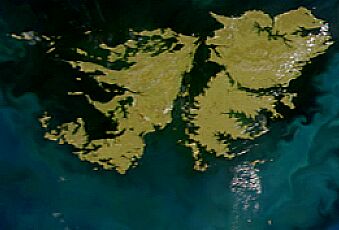Falkland Sound

Falkland Sound is the broad strait in the Falkland Islands which separates West Falkland and East Falkland. It runs in a straight line southwest - northeast between the two.
The name of the strait is older than that of the islands, the former giving a name to the latter.
Name
The sound was named by John Strong in 1690 for Viscount Falkland, the name only later being applied to the archipelago and its two largest islands.
Captain John Strong of the Welfare made the first recorded landing on either of the main islands (West and East Falkland) on 29 January 1690, at Bold Cove (near Port Howard) just off Falkland Sound.
Spanish explorers inevitably gave their own name to the strait; Estrecho de San Carlos after a Spanish ship, San Carlos, which visited in 1768 (almost a century after the strait had already received a name on British charts). This ship does however give a name to San Carlos Water, an inlet of East Falkland, which in turn names a river and two settlements on the inlet.
Geography
Several islands lie in Falkland Sound, amongst them:
- North West
- Narrows Island
- The Swan Islands (Swan Island, North Swan and West Swan)
- The Tyssen Islands
- Sandbar Island
- Great Island
- Wedge Island
- Calista Island
- Wolfe Island
- Ruggles Island
Eddystone Rock is at the northern end of the Sound. The Arch Islands are at the southern end.
Settlements on the sound include Ajax Bay, Port San Carlos and San Carlos on East Falkland and Port Howard, Port Edgar and Fox Bay on West Falkland.
Inlets and bays on the Sound include: Fox Bay, Port Howard (West Falkland); Grantham Sound, San Carlos Water, Ruggles Bay (East Falkland).
Geology
| Folding diagrams of West and East Falkland: |
 |
 |
About 400 million years ago part of Gondwanaland, which broke from what is now Africa and drifted westwards relative to Africa.[1] During the mid-Jurassic period[2] (about 170 million years ago) the land fragment that was to become East Falklands and the land fragment that was to become West Falklands rotated about 120° relative to each other. As a result, the fold lines in West Falkland run almost north-west to south-east, parallel to the Sound.
Those in the northern part of East Falkland run east-west, forming the eastern part of northern entrance to the Sound and bordering on the northern banks of San Carlos Water. The boundary between these two land fragments, the Falkland Sound Fault, lies close to and parallel with the western shore of the Sound. Lafonia, which is a much newer formation, has no folds.
References
- ↑ Otley H, Munro G, Clausen A and Ingham B. (2008). "Falkland Islands - State of the Environment Report". Falkland Islands Government and Falklands Conservation, Stanley. http://www.epd.gov.fk/wp-content/uploads/Falkland%20Islands%20State%20of%20the%20Environment%20Report%202008_final_sm.pdf. Retrieved 2010-06-05.
- ↑ P Stone, PC Richards, GS Kimbell, RP Esser & D Reeves (2008). "Cretaceous dykes discovered in the Falkland Islands: implications for regional tectonics in the South Atlantic". Journal of the Geological Society 165 (1): 1–4. doi:10.1144/0016-76492007-072. http://jgs.lyellcollection.org/cgi/content/abstract/165/1/1.
- Southby-Tailyour, Ewen - Falkland Island Shores